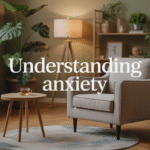Your body is constantly sending you messages, and when it comes to anxiety, these signals are impossible to ignore. Many people don’t realize that racing hearts, tight muscles, and stomach knots aren’t just random discomfort—they’re your body’s natural warning system telling you that anxiety is taking hold.
This guide is for anyone who wants to understand what their body is trying to tell them about stress and worry. Whether you’ve noticed new physical symptoms lately or you’re curious about the connection between your emotions and physical sensations, learning to read these anxiety warning signs can help you take action before things spiral.
We’ll walk through how your body’s natural warning system works and why it kicks into high gear during anxious moments. You’ll discover the most common physical symptoms of anxiety—from headaches and muscle tension to shortness of breath and digestive issues. We’ll also cover the emotional signals that often show up alongside these physical signs, and most importantly, when these body warnings mean it’s time to reach out for professional support.
Understanding How Your Body’s Natural Warning System Works

Why Your Body Creates Anxiety as a Protective Mechanism
Anxiety often gets misunderstood as something to eliminate, but it’s actually your body’s sophisticated alarm system working exactly as designed. Your brain perceives anxiety as part of your healthy, adaptive alarm system – not a random malfunction or weakness. When your brain detects a potential threat, it triggers defensive survival circuitry in the amygdala through a non-conscious process of threat detection and response.
This body’s natural warning system serves a crucial evolutionary purpose. Think of anxiety as your brain’s built-in alert mechanism that helped our ancestors survive by instantly recognizing danger and preparing for life-saving action. Whether facing a wandering car, developing concerning symptoms, or navigating social situations, your anxiety warning signs activate to protect you from physical threats to health, social threats to relationships, or psychological threats from overwhelming thoughts and feelings.
The remarkable aspect of this system is its precision – anxiety is never random. It responds to anything your brain perceives as potentially dangerous to your basic needs or well-being. Your brain releases stress hormones and activates various organs to prepare your body for protective action, creating that familiar urgent drive to respond to the perceived threat.
How Your Autonomic Nervous System Triggers Fight-or-Flight Responses
When your brain’s threat detection system activates, the sympathetic nervous system immediately deploys your body’s internal emergency response team. This creates a well-choreographed sequence of physical symptoms of anxiety that prepare you for action. Your heart rate increases, breathing quickens, and stress hormones flood your system to boost oxygen and blood sugar levels.
These physical signs of stress and anxiety include heart-pounding, stomach knotting, fingers tingling, breathlessness, or light-headedness. The body releases cortisol, the primary stress hormone, while serotonin levels shift to influence your mood and emotional response. This intricate chemical cascade creates those familiar sensations of racing thoughts and heightened awareness.
Your autonomic nervous system treats every threat signal with the same intensity, whether the danger is real or perceived. The firefighters within your body – stress hormones – rush to activate muscles and organs without initially knowing if the threat is genuine. This immediate response system evolved over millions of years to provide split-second protection, and it continues functioning the same way in modern situations.
The fascinating aspect is how your brain literally watches your protective behaviors. When it observes you acting defensively, it assumes the threat must be real, reinforcing the anxiety response pattern and strengthening future threat detection.
When Normal Anxiety Becomes a Problematic Pattern
The challenge emerges when distinguishing between true alarms and false alarms in your anxiety body warnings. True alarms occur when your brain accurately assesses genuine danger – like an approaching car or a real performance issue at work. False alarms happen when the threat isn’t real, likely, or as severe as perceived, yet your body produces exactly the same alarm activation.
False alarms are incredibly common because your brain is designed to over-predict threat from an evolutionary perspective. When situations are ambiguous or potentially risky, your threat detection system follows a “better safe than sorry” approach. This threat bias exists in all animals as a survival feature, not a bug in the system.
Problems develop when you consistently respond to false alarms with safety behaviors – avoidance strategies aimed at reducing anxiety in the short term. Examples include excessive medical checking for mild symptoms, avoiding social situations due to fear of judgment, or suppressing threatening thoughts and feelings. While these behaviors provide immediate relief, they actually strengthen threat beliefs and anxiety problems over time.
Recognizing anxiety in your body becomes problematic when safety behaviors prevent you from learning through experience that perceived threats aren’t real or as dangerous as imagined. Your brain cannot distinguish between true and false alarms when you quickly escape situations, maintaining and reinforcing the anxiety response pattern instead of allowing natural resolution.
Recognizing the Physical Warning Signs Your Body Sends

Cardiovascular Symptoms That Signal Rising Anxiety
Your heart often serves as the first alarm bell when anxiety begins to escalate. One of the most common anxiety body warnings is an increased heart rate, which can feel like your heart is racing even when you’re sitting still. This rapid heartbeat, medically known as tachycardia, occurs as your body’s natural fight-or-flight response kicks into gear.
You may also experience heart palpitations – a sensation where your heart feels like it’s fluttering, pounding, or beating irregularly. These physical symptoms of anxiety can be particularly alarming because they mimic serious cardiac conditions, often leading to increased worry about your health.
Chest pain is another cardiovascular warning sign that your body sends when anxiety levels rise. This discomfort can range from a tight sensation to sharp pains across your chest area. While anxiety-related chest pain is generally harmless, it’s one of the most frightening physical manifestations that can trigger panic attacks.
Digestive and Breathing Issues That Indicate Stress
Now that we’ve covered cardiovascular symptoms, let’s examine how anxiety affects your digestive system and breathing patterns. Upset stomach and digestive problems are frequent companions of anxiety, manifesting as nausea, stomach butterflies, or general gastrointestinal discomfort.
Your breathing patterns change dramatically when anxiety warning signs emerge. Rapid breathing or hyperventilation is a telltale sign that your body is responding to perceived stress. This shallow, quick breathing can make you feel lightheaded or dizzy, creating a cycle where the breathing difficulties themselves become a source of additional anxiety.
Shortness of breath often accompanies hyperventilation, making you feel like you can’t get enough air despite breathing rapidly. This symptom can be particularly distressing and may trigger feelings of panic or impending doom.
Muscle Tension and Nervous System Responses to Watch For
With this in mind, your muscular and nervous systems provide additional warning signals that shouldn’t be ignored. Trembling or shaking is a visible sign that your nervous system is in overdrive, often starting in your hands but potentially affecting your entire body.
Muscle tension throughout your body is another key indicator of rising anxiety levels. You might notice your shoulders becoming rigid, your jaw clenching, or tension headaches developing as your muscles remain in a constant state of alertness.
Sweating occurs as your body’s temperature regulation system responds to stress, even in cool environments. This can range from mild perspiration to profuse sweating that feels disproportionate to your activity level or surroundings.
Feeling weak or tired despite not engaging in physical activity is another common response. Your body expends significant energy maintaining this heightened state of alert, leaving you feeling drained and fatigued.
Restlessness and feeling nervous or tense are additional nervous system responses that signal your body’s recognition of stress. You may find it difficult to sit still, feel jittery, or experience an overall sense of unease that you can’t quite pinpoint.
Identifying the Emotional Signals That Accompany Physical Symptoms

Mental Warning Signs That Connect to Physical Discomfort
Now that we understand how your body’s natural warning system works, it’s crucial to recognize that anxiety manifests through distinct mental patterns that directly connect to physical discomfort. The mind-body connection reveals itself through specific emotional symptoms of anxiety that often accompany or precede physical manifestations.
Constant fear and obsessive worrying represent the most common mental warning signs that your body is preparing for perceived threats. When your mind gets trapped in “what if” spirals, your nervous system interprets these racing thoughts as actual danger, triggering the fight-or-flight response that produces those uncomfortable physical sensations. Racing thoughts and catastrophic thinking patterns—where you always imagine the worst-case scenario—create a direct pathway to physical symptoms like chest tightness, nausea, and muscle tension.
Emotional numbness and the inability to relax, even in calm environments, signal that your nervous system is stuck in hypervigilance mode. This constant state of alertness keeps your body primed for danger, leading to chronic physical tension and exhaustion. Black and white thinking, where you see situations as all good or all bad with no middle ground, intensifies this cycle by maintaining your body’s stress response.
Perfectionism and the fear of making mistakes create persistent mental pressure that your body interprets as ongoing threat, manifesting as headaches, upset stomach, and muscle soreness. When your mind constantly scans for danger or rejection, your autonomic nervous system remains activated, producing the physical symptoms that doctors often see without any underlying medical condition.
How Concentration Problems and Irritability Reveal Hidden Anxiety
Previously, many people focus so intently on physical symptoms that they don’t realize anxiety started with mental and emotional changes. Concentration problems and irritability serve as critical early warning signs that anxiety is building in your system before it fully manifests as physical discomfort.
The inability to focus occurs when your brain dedicates excessive resources to monitoring for potential threats, leaving little mental capacity for regular tasks. This cognitive overload creates a feedback loop where frustration about poor concentration generates more anxiety, which further impairs focus and triggers physical symptoms like tension headaches and digestive issues.
Irritability and edginess emerge when your nervous system operates in a heightened state of alertness. Small disruptions that wouldn’t normally bother you become overwhelming because your body is already primed for fight-or-flight. This emotional reactivity often precedes more obvious physical anxiety symptoms, making it an important early warning sign to recognize.
Jumping from one anxious thought to another with no relief indicates that your mind cannot settle into a calm state, keeping your body’s stress response continuously activated. This mental restlessness directly contributes to physical symptoms like muscle tension, shallow breathing, and sleep disturbances. When you notice your mind cannot find peace, it’s often your body’s way of signaling that anxiety levels are rising before physical symptoms become severe.
Understanding the Cycle Between Physical and Emotional Symptoms
With this understanding of mental warning signs, it becomes clear that physical and emotional symptoms of anxiety create a self-perpetuating cycle that can quickly spiral out of control. The autonomic nervous system, which controls your heart rate, breathing, and digestive functions, responds to both actual physical threats and perceived emotional dangers in identical ways.
When anxiety produces physical symptoms like headaches, nausea, or chest pain, your reaction to these sensations can intensify both the physical discomfort and emotional distress. The more you focus on concerning physical symptoms, the more alarmed you become, which triggers additional stress hormones and makes the physical sensations worse. This creates what experts describe as a vicious cycle where anxiety symptoms feed on themselves.
Your body’s fight-or-flight response can become overactive, interpreting everyday stressors like emails, social plans, or routine interactions as dangerous threats. For individuals with trauma histories or sensitive nervous systems, this response activates too easily, creating chronic hypervigilance that manifests as both physical tension and emotional exhaustion.
The cycle intensifies when you begin avoiding activities or isolating from others due to fear of experiencing symptoms. This avoidance behavior reinforces anxiety by preventing your nervous system from learning that situations are actually safe, keeping both emotional and physical symptoms active. Breaking this cycle requires recognizing that physical symptoms often stem from emotional stress rather than medical conditions, allowing you to address the root cause rather than just the physical manifestations.
Knowing When Your Body’s Warnings Require Professional Help

Distinguishing Between Normal Anxiety and Disorder-Level Symptoms
Understanding the difference between everyday anxiety and an anxiety disorder is crucial for recognizing when your body’s warnings require professional attention. Normal anxiety is a shared human experience – whether it’s speaking in front of a large group or taking a test. This type of anxiety can actually serve as a catalyst for diligent preparation and positive action.
However, when anxiety transforms into disorder-level symptoms, it becomes something entirely different. According to mental health professionals, it’s a disorder when it interrupts your life. The key distinction lies in functional impairment: when anxiety interferes with everyday functioning, prevents you from leaving the house, completing work tasks, or participating in activities you normally enjoy, it crosses the threshold into disorder territory.
Several warning signs indicate disorder-level symptoms:
- Avoidance behaviors: Finding yourself consistently avoiding certain situations or places you need to visit
- Relationship impact: When irritability resulting from anxiety affects important relationships at home or work
- Duration and intensity: Persistent worry, emotional instability, and procrastination that severely inhibit personal happiness and career success
- Physical manifestations: Chronic physical symptoms like headaches, stomachaches, heart racing, sweating, or shortness of breath that interfere with daily life
The statistics are telling: in the U.S., anxiety disorders affect 26.4% of men and 40.4% of women during their lifetime, making recognition of these disorder-level symptoms essential for seeking appropriate help.
When Physical Symptoms Need Medical Evaluation
Now that we’ve covered the distinction between normal and disorder-level anxiety, it’s important to understand when physical symptoms warrant medical attention. Your body’s warning signals often manifest physically before emotional symptoms become apparent, making medical evaluation crucial for proper treatment.
Physical symptoms requiring medical evaluation include:
| Symptom Category | Specific Signs | When to Seek Help |
|---|---|---|
| Sleep Disturbances | Chronic insomnia, restless sleep | When affecting daily functioning for 2+ weeks |
| Cardiovascular | Elevated blood pressure, heart palpitations | Persistent symptoms not related to physical activity |
| Pain-Related | Chronic headaches, muscle tension, unexplained pain | When pain worsens in presence of anxiety |
| Digestive | Persistent stomachaches, nausea, appetite changes | Ongoing symptoms without medical cause |
Medical evaluation becomes essential because untreated anxiety often progresses beyond the initial disorder. Healthcare professionals emphasize that untreated anxiety takes a toll on the entire body system. It has been associated with:
- Elevated cardiovascular disease risk
- Increased blood pressure
- Worsening of existing chronic medical conditions
- Intensified pain experiences
The interconnection between anxiety and physical health means that people with concurrent medical problems and anxiety need proper treatment, as untreated anxiety can worsen existing conditions. Additionally, individuals may turn to unhealthy coping mechanisms like tobacco, cannabis, alcohol, or overuse of pain medications, creating additional health complications.
For older adults, the risks are compounded, as anxiety can lead to seeking benzodiazepines and sleep medications that increase risks of falls, delirium, and confusion.
Treatment Options That Address Both Physical and Emotional Components
With the understanding of when professional help is needed, it’s essential to explore comprehensive treatment approaches that address both physical and emotional aspects of anxiety. Mental health professionals emphasize a systematic approach that prioritizes non-pharmaceutical interventions before considering medication.
Primary Treatment Approaches:
Cognitive Behavioral Therapy (CBT) serves as the number one psychotherapeutic tool for managing anxiety. This evidence-based approach helps individuals understand their triggers and develop healthier coping mechanisms for both physical and emotional symptoms.
Non-Pharmacological Interventions:
- Deep breathing exercises: The 5-3-8 breathing pattern (inhale for 5 counts, hold for 3, exhale for 8) activates the parasympathetic nervous system, serving as “your own personal chill pill”
- Regular exercise: Rhythmic, aerobic exercise of moderate to low intensity (walking, jogging) for 15-30 minutes at least three times weekly significantly reduces anxiety
- Alternative activities: Tai chi, yoga, meditation, bike riding, dancing, and walking all help reduce anxiety symptoms
Medication Considerations:
When non-pharmaceutical approaches prove insufficient, healthcare providers typically recommend serotonin reuptake inhibitors as the first-choice medication. These medications address both anxiety and depression with fewer side effects and no risk of dependency associated with benzodiazepines.
Timeline Expectations:
Professional treatment requires patience and commitment. Studies indicate that even with medication, meaningful improvement can take anywhere from six months to two years. This timeframe allows individuals to develop a better understanding of their anxiety triggers and learn sustainable management strategies.
The comprehensive approach ensures that both the physical manifestations (headaches, heart palpitations, sleep issues) and emotional components (worry, irritability, avoidance) are addressed simultaneously, providing the best outcomes for long-term anxiety management.
Daily Management Techniques to Support Your Body’s Balance

Lifestyle Changes That Reduce Anxiety Triggers
Now that we’ve covered how to recognize when your body’s warnings require professional attention, let’s explore the daily management techniques that can help support your body’s natural balance. Making strategic lifestyle changes forms the foundation of effective anxiety management techniques.
Avoiding Substance Triggers: Alcohol and recreational drugs can cause or worsen anxiety symptoms, making your body’s warning signals more intense. These substances disrupt your natural balance and can create additional physical symptoms of anxiety. If you’re struggling to quit on your own, seeking support from healthcare professionals or support groups is essential.
Prioritizing Sleep and Recovery: Quality sleep directly impacts how your body processes stress and anxiety. When sleep is compromised, your body’s natural warning system becomes more sensitive, triggering anxiety warning signs more frequently. Establishing consistent sleep routines helps regulate the physical manifestations of anxiety.
Dietary Modifications: Incorporating healthy foods like vegetables, fruits, whole grains, and fish may help reduce anxiety levels. Additionally, eliminating or reducing caffeine and quitting smoking are crucial steps, as nicotine and caffeine can intensify body signals anxiety and worsen existing symptoms.
Physical Activity: Regular exercise serves as a powerful stress reducer that can improve mood and overall health. Physical activity helps process stress hormones and can reduce the intensity of physical signs of stress and anxiety. Starting slowly and gradually increasing activity levels ensures sustainable progress.
Building Your Personal Toolkit of Coping Strategies
Previously, I’ve discussed how lifestyle changes form the foundation, but building a personalized toolkit of coping strategies is equally important for managing anxiety’s physical and emotional manifestations.
Stress Management Techniques: Visualization, meditation, and yoga represent proven relaxation techniques that can ease anxiety symptoms. These practices help you recognize anxiety in your body early and respond appropriately to your body’s warnings before they escalate.
Breathing Exercises: Controlled breathing techniques provide immediate relief when experiencing anxiety warning signs. These exercises help you feel more in control during moments when physical symptoms of anxiety emerge. Proper breathing is often forgotten during panic episodes, making it a crucial skill to develop.
Mindfulness Practices: While mindfulness can be helpful for some anxiety disorders, it’s important to note that it may intensify negative thoughts for certain individuals. The National Institute for Health and Care Excellence specifically advises against mindfulness for social anxiety. If mindfulness increases distress, exploring alternative coping strategies is recommended.
Journaling and Self-Monitoring: Keeping track of personal experiences helps identify what triggers stress and what provides relief. This practice enables you and healthcare professionals to better understand your specific anxiety patterns and body’s natural warning system responses.
Creating Support Systems for Long-Term Anxiety Management
With this in mind, next, we’ll explore how building robust support systems enhances your ability to manage anxiety’s long-term effects on your body’s balance.
Professional Support Networks: Maintaining consistent contact with healthcare teams and mental health professionals ensures comprehensive anxiety management. Sticking to treatment plans, taking medications as directed, and keeping therapy appointments creates a foundation for recognizing anxiety symptoms effectively.
Family and Social Connections: Don’t let worries isolate you from loved ones or activities. Involving family and friends in your understanding of anxiety disorders provides additional support for when your body signals anxiety. Social connections help maintain perspective when physical symptoms of anxiety feel overwhelming.
Educational Support: Learning about your specific anxiety disorder helps you understand what might be causing your condition and which treatments work best. This knowledge empowers you to better interpret your body’s natural warning system and respond appropriately to various anxiety warning signs.
Peer Support Groups: Connecting with others who experience similar challenges provides validation and practical strategies. These groups offer insights into how others manage their physical signs of stress and anxiety, expanding your toolkit of effective techniques.
Your body’s warning system for anxiety is remarkably sophisticated, sending both physical and emotional signals when stress levels rise. From racing heartbeats and muscle tension to irritability and difficulty concentrating, these symptoms serve as your internal alarm system. Learning to recognize these early warning signs – whether it’s dizziness, shortness of breath, or persistent worry – empowers you to take action before anxiety becomes overwhelming.
The key lies in listening to what your body is telling you and responding appropriately. Simple techniques like deep breathing, regular exercise, avoiding caffeine, and practicing stress management can help maintain balance. However, when anxiety becomes hard to control, persists for months, or disrupts important areas of your life, it’s time to seek professional help. Remember, anxiety disorders are highly treatable through counseling, medication, and support systems. Your body’s warnings aren’t something to fear – they’re valuable information guiding you toward better mental health and well-being.





